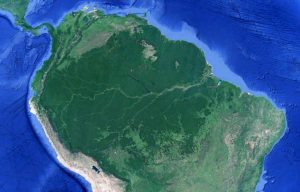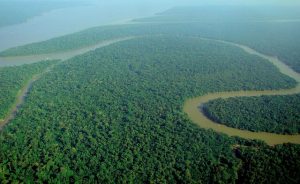
There has been longstanding debate as to whether the Amazon rainforest was extensively modified by humans in the past. Today, the Amazon forest covers roughly 5,500,000 km2, spanning nine different countries in South America. It is responsible for regulating the planet’s temperature, humidity, and atmospheric carbon content by storing over 100 billion metric tons of carbon in vegetation. Additionally, it contains over 10% of the world’s biodiversity, including thousands of tree species.
The Amazon basin is home to over 30 million people today, including several hundred diverse ethnic groups that have called this land home for millennia. The size and degree of mobility of many indigenous communities is variable, and has been so for generations. However, there has been considerable debate among scientists as to the affect humans have had on the landscape over time. Evidence exists that suggests some areas of the rainforest were extensively managed or even deforested to accommodate densely populated pre-Columbian settlements. This includes the dark anthropogenic soil terra preta used for gardening and agricultural practices, as well as the outlines of abandoned communities and geoglyphs identified from aerial observations and surveys. But was the entire forest equally affected?

In a new study, STRI archaeobotanist Dolores Piperno and colleagues have found areas of the northwest Amazon that show little to no evidence of human impact over the past 5000 years. By examining the fire history (evidence of burning to clear vegetation, a common practice in pre-Columbian and modern times) and plant residues, including silica bodies unique to certain species called phytoliths, the team identified an area of northeast Peru that demonstrated little change across the millennia to the present day.

Significantly, the researchers focused on the interfluvial zones or tierre firme between rivers, which make up the majority of the Amazon region. Until recently, most studies have focused on the flooded river zones, many of which are used by people today. If humans were to have a significant impact on the forest, evidence should theoretically be found in the tierre firme zones as well. The fact it was not apparent in this study does not necessarily rule out the possibility that some communities lived in interfluvial zones, but it does provide evidence that humans did not significantly alter the entire forest, leaving some regions largely untouched.
The polarizing argument as to whether the Amazon is mostly pristine or anthropogenically altered undermines the fact that it is an extensive, complex forest with a long history. As Piperno and colleagues argue, generalizations regarding how pre-Columbian humans affected the region cannot be substantiated with empirical evidence. Amazon societies, like the forest itself, was and is complex.
The original article (which is open access) can be found here: https://www.pnas.org/content/early/2021/06/04/2022213118
Piperno, Dolores R., Crystal H. McMichael, Nigel C. A. Pitman, Juan Ernesto Guevara Andino, Marcos Ríos Paredes, Britte M. Heijink, and Luis A. Torres-Montenegro. 2021. A 5,000-year vegetation and fire history for tierra firme forests in the Medio Putumayo-Algodón watersheds, northeastern Peru. Proceedings of the National Academy of Sciences. DOI: 10.1073/pnas.2022213118.